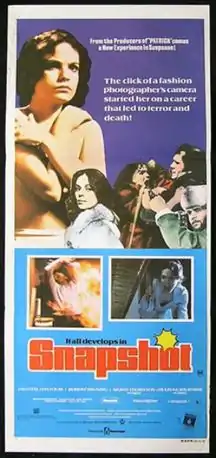Snapshot (film)
Snapshot (also known as The Day After Halloween and One More Minute in the US) is a 1979 Australian thriller film directed by Simon Wincer in his feature film debut. It stars Sigrid Thornton, Chantal Contouri and Robert Bruning. The film was shot on an estimated budget of $300,000.
| Snapshot | |
|---|---|
 Film poster | |
| Directed by | Simon Wincer |
| Produced by | Antony I. Ginnane |
| Written by | Everett De Roche Chris De Roche |
| Starring | Sigrid Thornton Chantal Contouri Robert Bruning |
| Music by | Brian May |
| Cinematography | Vince Monton |
| Edited by | Philip Reid |
Production company | |
| Distributed by | Filmways |
Release date |
|
Running time | 92 minutes |
| Country | Australia |
| Language | English |
| Budget | $300,000 (est.)[1] |
Plot
After being thrown out of her own home by her puritanical mother, a young, naive, pretty and impressionable hairdresser named Angela is lured into modelling by an impudent as well as equally bumptious model, named Madeline, who at her behest is talked into stripping for what is supposed to be a special photo shoot more or less her first modeling gig. However while Angela's future seems bright for the moment, her gaiety unfortunately is short lived as she has no idea what baleful things surround her. It is not too long after this that she subsequently starts to fall victim to being stalked by a sinister, mysterious assailant who will stop at nothing to get his hands on Angela in a twisted game of Cat & Mouse. Her peculiar ex-boyfriend Daryl is also rather relentlessly possessive, in addition to quite eerie, plus seems to be hiding something. Could he be the one responsible all of this? Who exactly can she trust? Meanwhile, Madeline's husband Elmer also wants to photograph her naked to which the mother then proceeds to rob the girl that ensues in a desperate fight for her life. Will she succeed?
Cast
- Sigrid Thornton as Angela
- Chantal Contouri as Madeline
- Robert Bruning as Elmer
- Hugh Keays-Byrne as Linsey
- Denise Drysdale as Lily
- Vincent Gil as Daryl
Production
Ginnane had originally intended to make a film after Patrick called Centrefold, based on a script by Chris Fitchett, and raised money for it. He showed it to TV director Simon Wincer who only liked the fact the script was set in the modelling world and there was a Mr Whippy Van. Ginnane then commissioned Everett de Roche to write a new screenplay. Wincer says he and de Roche re-wrote it in three weeks, and the film took eleven weeks from the first day of shooting until sitting down with the release print.[2]
Wincer planned to use a different actress to play Angela but she turned it down because she did not think the script was good enough "which was pretty amazing for someone who had only done television soap operas."[3] Sigrid Thornton was cast two days before shooting started.
"It was a very easy film to make and probably my most pleasant experience to date" said Ginnane in 1979. The budget was $100,000 less than for Patrick (1978).[1]
Ginnane then took the film to the US where he sat down with an editor and cut 12 minutes out of the film. According to Wincer, these were mostly lighter scenes, and a moment where it is explained Elmer is married to Madeline. This meant Wincer was not happy with the final result although he says "for what it is, it is quite a good little film."[4]
The musical soundtrack was produced for release by Brian May and Phillip Powers for the 1M1 Records label many years later on CD under its overseas title.
Release
The film performed poorly at the Australian box office, only running a week in Melbourne, but sold very well overseas.[5]
Home media
Snapshot was first released on DVD in the United States on 26 November 2002. A second release was made under the title The Day After Halloween via Scorpion Releasing on 24 July 2012 and was presented in its original aspect ratio of 2.35:1. It was given a Blu-ray release by Vinegar Syndrome under its original title on 29 August 2017 with special features including the Australian version presented in SD and extended interviews from Not Quite Hollywood.
References
- Beilby, Peter and Scott Murray, ‘Antony I. Ginnane’, Cinema Papers, January/February 1979 p234
- Beilby & Murray 1979-80 p 641
- Beilby & Murray 1979-80 p642
- Beilby & Murray, 1979-80 p641
- David Stratton, The Last New Wave: The Australian Film Revival, Angus & Robertson, 1980 p253
External links
- Snapshot at IMDb
- Snapshot at Rotten Tomatoes
- Snapshot at TCMDB
- Snapshot at Australian Screen Online
- Snapshot at Oz Movies